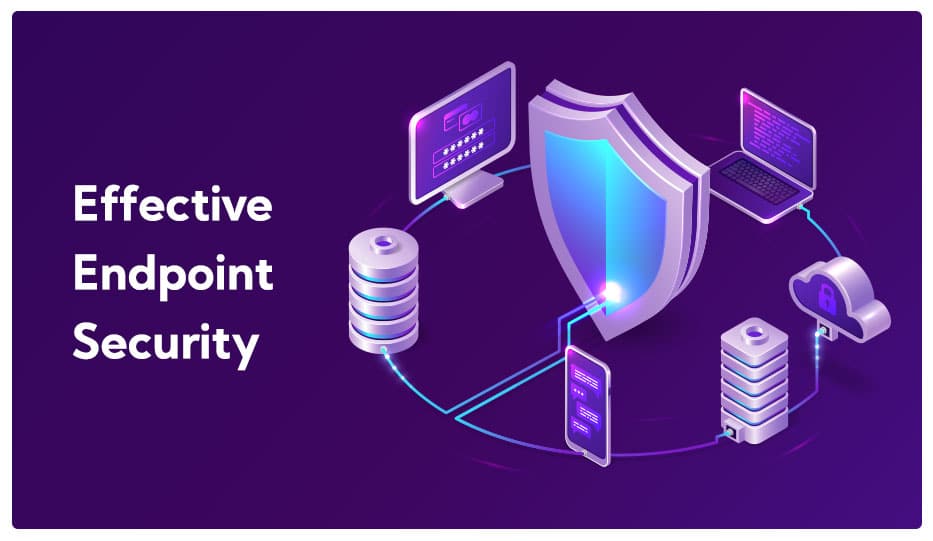
Endpoint security is a tricky subject, especially considering all the many devices that communicate within and outside a network. Add to that the requirement to connect to data remotely, from not-so-secure personal devices like mobiles and tablets, and the role of effective endpoint security becomes ever more crucial. The attack surface of an organization (comprising of all the devices, network segments, and communication channels) is widening, and the task before security enforcers is to minimize exposure to it.
Security experts try to do that by setting stringent rules that will block unauthorized requests, educate the employees of an organization on exemplary security practices, and initiate protocols and processes for maintaining total security within an organization.
We need some automated solution for effective endpoint security, that much is clear.
But what makes a tool effective against endpoint threats? Are there favorable features to look out for? Definitely there are.
The 4 Key Factors That Enable Effective Endpoint Security
Visibility
You can’t throw darts in the dark and expect to hit the bulls-eye. Only with proper knowledge can you understand how your devices behave, how they perform vis-à-vis security, and how they face up to prevalent security threats. For this, security specialists need complete visibility across your endpoint devices. Then they can provide valuable insights into:
- The type of access privileges that can be granted to the device.
- Vulnerable devices in a network that can risk compromising the entire network
- The kind of applications that run on an endpoint and whether they can become a threat to the endpoint security.
- Reports on vulnerabilities that need to be patched ASAP.
Endpoint visibility seems simple but when it comes to real-life networks, ends up becoming plenty complex. This is owing to the many home devices employees use, alternate office devices, and changing network conditions. If it’s a product-oriented business, endpoint security also needs to care for Point-Of-Sale devices, other SMART equipment, and data storage devices.
Proactive controls
Okay, you have total endpoint visibility across your entire network. But you still need hands-on efforts from a security expert who can work on the data provided to understand how to move ahead. Effective being the operative keyword of our discussion, this is not very favourable. Imaging going to a doctor who only gives you the diagnosis and then ushers you out. You need the medicine! An effective endpoint security mechanism will proactively employ security policies and rules that will automatically ‘harden’ your security devices.
An endpoint security tool that can spot an oncoming attack from miles away is way better than one which simply gives expert reports and does nothing.
Today, cyber threats are evolving rapidly. Scripts are being written that can trick the rules of traditional hardening and steal data or make unauthorized requests to an application.
An effective endpoint security will adapt to an oncoming attack and mould itself to provide the best possible solution.
Proactive controls will help security teams identify attacks traditional systems cannot and respond in time to defend against an oncoming attack.
Self defense
Prevention is better than cure. We are strong advocates of this philosophy, especially when it comes to fighting off a malware. Once a malware has entered the system, the headaches of weeding it out and mitigating the damage multiply fast.
But we don’t live in a perfect world and an attack can creep in. An effective endpoint security is one that can then protect the system once an attack has already occurred. Attacks can be as silent as they are deadly and the endpoint security solution should be able to detect it anyway. It can’t rely on just on the rule-based filtering.
Imagine if an endpoint security mechanism has setup a rule not to allow anything other than PDFs to minimize the risk of malware. But a hacker can imitate the behaviour of a valid request, still upload a PDF and still escape detection. This happens because he subverted the rule in place and was able to cloak a malicious request under a valid-looking one.
The best and most effective endpoint security mechanisms that move beyond rule-filtering and get into a behaviour’s analysis mode. It will detect patterns in a user’s behaviour and take decisions based on that input.
Upon detection, the security mechanism should also move fast to block further damage and spread of the malware. In short, stop the lateral movement of the malicious payload so the damage is isolated and ‘sandboxed’.
Self-healing
Once the threat has been handled, the damage minimized, and the system cured again, endpoint security also needs to roll-back to a previous checkpoint so that corrupted data is no longer present in the system.
Self-healing properties are highly desirable qualities in an effective endpoint security mechanism, given that the trend of remote working is at an all-time high. At location, an I team could easily restore the systems to a previous, clean state.
Doing this task remotely is tough and time-confusing, causing down-times and loss of productivity.
Self-healing endpoint security mechanisms clean up after the mess left behind by malware. They will scour the entire system for traces of lingering data corruption, fix up any gaps in the access to the files, and ‘revive’ the system fully, all the while allowing the employee to continue working online.
Also read: Endpoint Security With Considerations For Cloud Computing
The Logix Way of Effective Endpoint Security
We take a holistic look at your requirements and help channel our intelligent endpoint security mechanism to fit your requirements. We monitor your endpoints and analyze behaviour anomalies that indicate potential threats. Logix then helps you to mitigate these impending risks. We do this by keeping the simplicity of deployment in mind, and ensure you face no trouble interacting with our effective endpoint security mechanisms. More details on our way of working have been described on our Endpoint Security Service page.